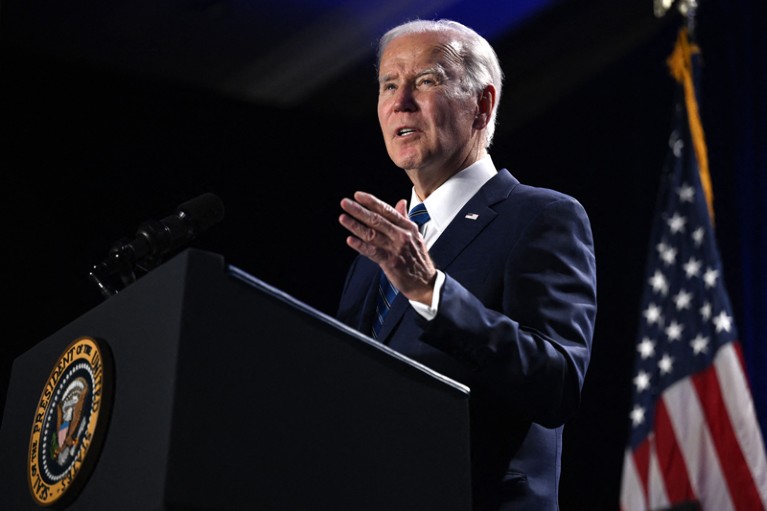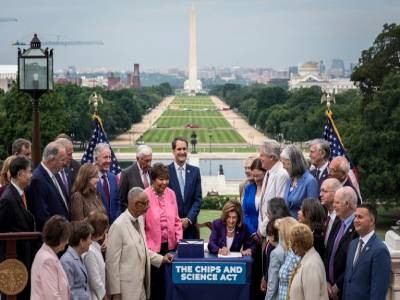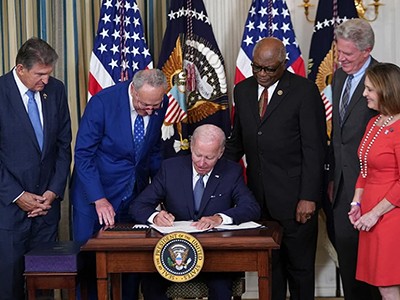
President Joe Biden released a budget proposal on 9 March that, he said, “outlines crucial investments to out-compete China globally”.Credit: Andrew Caballero-Reynolds/AFP/Getty
Facing a potential re-election battle next year, President Joe Biden laid out broad funding priorities for the US government on 9 March. His proposed budget for 2024 would invest new research funds into a range of programmes designed to achieve goals in scientific innovation, domestic manufacturing and clean energy, among others.
Biden’s budget was light on details, with funding specifics not yet available for many federal science agencies, but some clear winners emerged. In particular, the US National Science Foundation (NSF) would see its budget increase by nearly 19%, while the US Department of Energy’s office of science — a major investor in the physical sciences — would see its budget increase by nearly 9%.
Billions more for US science: how the landmark spending plan will boost research
The amount of money going to federal agencies during fiscal year 2024, which begins on 1 October, will be decided by Congress, which is divided between a Republican-led House of Representatives and a Democrat-led Senate. It’s going to be a tough budget negotiation, says Neal Lane, former director of the NSF and senior fellow in science and technology policy at Rice University’s Baker Institute in Houston, Texas. But he says this budget, particularly the request for the NSF, emphasizes that Biden, a Democrat, is committed to innovation in science and technology, with an eye towards being competitive with China and other parts of Asia.
Adding to the tension, the United States is facing a looming fiscal crisis in the coming months. Congress must raise or suspend a self-imposed limit on the national debt if the country is to avoid defaulting on what it owes. However, Republicans are threatening to block any effort to raise the debt limit unless it is accompanied with significant spending cuts.
“We will see a battle over funding cuts, not just for research and development, but for the budget overall,” says Joanne Carney, chief government-relations officer for the American Association for the Advancement of Science in Washington DC. Citing recent breakthroughs in everything from fusion energy to the development of COVID-19 vaccines, she says it will be incumbent on the US scientific community to make the case for continuing investments in research, development and innovation.
Competing with China
Many of Biden’s fiscal requests point to his administration’s desire to ensure the United States remains competitive with China. They build on major legislation passed by Congress last year, known as the CHIPS and Science Act, which authorized US$280 billion to be doled out for domestic manufacturing of semiconductors and for research in the applied sciences, at agencies such as the NSF.
The NSF, which funds about a quarter of US academic research, would receive a budget boost of 18.6% over last year, to $11.3 billion under Biden’s plan. That includes $2 billion for research and development in technologies such as artificial intelligence, biotechnology and quantum computing, and $1.8 billion for programmes intended to expand — and diversify — the scientific workforce.
It also includes $1.2 billion for the Directorate for Technology, Innovation and Partnerships, established in March 2022 to help bring innovations from the laboratory to the market. China has heavily invested in research and development, so lawmakers bet on a directorate at the NSF, which has mostly been known as a funder of basic research, to do the same.
Biden’s proposed budget shows the country aims to meet the challenges posed by China and other highly technological countries, Lane says. “This is a very significant statement on the part of the administration that we really are serious, that we recognize that we’re in a race.”
The US National Institute of Standards and Technology would get a $163 million, or 77%, increase, to $375 million, to bolster research in industrial technology, including a nationwide network of manufacturing institutes. And a public-private partnership known as the Manufacturing Extension Partnership, which supports small manufacturing businesses in all 50 states and Puerto Rico, would get a 58% increase, to $277 million.
In another field where the United States is trying to stay ahead of China — human space exploration — NASA would receive $8.1 billion for its Artemis programme, which is developing a line of rockets and spaceships to take astronauts back to the surface of the Moon. If approved, that would be a $500 million, or 6.6%, increase over last year’s funding. NASA flew its first Artemis mission, an uncrewed test flight, last November and aims to put boots on the Moon as early as 2025.
Bolstering US health
Although Biden’s budget proposal goes big on ensuring US competitiveness, it also aims to capitalize on lessons learnt from the COVID-19 pandemic to protect the country against future outbreaks.
The US Centers for Disease Control and Prevention (CDC) has been scrutinized for its response to the COVID-19 pandemic, and its leaders have vowed to revamp its structure and processes. Biden requested $11.5 billion for the agency, an increase of $2.3 billion, or 26%, from 2023 — reflecting concerns over the US public-health system. Georges Benjamin, the executive director of the American Public Health Association in Washington DC, says the increase is a good first step. “The public health system has been so underfunded for so long that the truth of the matter is it’s going to take a fair amount of money to make that right, but it’s a step in the right direction,” he says.
US mid-term elections: 3 ways science is on the line
The budget plan also calls for $20 billion over five years for pandemic preparedness. More than half of this funding would go to the Administration for Strategic Preparedness and Response, an agency that is responsible for dealing with public-health emergencies and maintaining the national stockpile of vaccines and treatments.
The US National Institutes of Health (NIH) in Bethesda, Maryland, might see $2.7 billion of this preparedness money if Biden’s request is successful. But otherwise, the NIH, which is the world’s largest funder of biomedical research, would receive a budget of $48.6 billion, reflecting an increase of only about 1.9% from 2023. “I’m quite disappointed in the NIH increase,” says Ellie Dehoney, the vice-president of policy and advocacy at Research!America, an organization in Arlington, Virginia, that advocates for health research. She adds that this amount is insufficient for the agency to invest in the basic research it is renowned for.
Even ARPA-H, an independent agency within the NIH that was founded last year and will invest in high-risk, high-reward life sciences research, would see a bigger increase — $1 billion — than the NIH under Biden’s plan. That’s a gamble, Dehoney says, given that ARPA-H is still in its infancy.
Protecting Earth and its people
Building on earlier legislation that provides more than half a trillion dollars for climate and energy over the coming decade, Biden’s budget would invest some $16.5 billion for climate science and energy innovation across multiple agencies. Another $4 billion would go towards “game-changing” technologies that could help lower greenhouse-gas emissions in areas such as buildings, aviation, manufacturing and fusion energy. Much of that money would flow through the US Department of Energy’s office of science, which would see its budget increase to $8.8 billion, including a record $1 billion investment in fusion programmes.
Scientists welcome ‘enormous’ US climate bill — but call for stronger action
In addition, the budget would provide $24 billion to help US communities prepare for the rising impacts of climate change, and another $7 billion to help communities that depend on oil, gas and coal extraction transition to clean energy.
The US Environmental Protection Agency would see its budget increase nearly 19%, to $12.1 billion. That includes $5 billion, an increase of nearly 18%, for climate programmes, as well as $1.8 billion for environmental-justice programmes that are intended to benefit disadvantaged communities.
Overall, Biden’s proposed budget reflects the priorities of the Democratic party and emphasizes applied science that can help solve national and global challenges, says Michael Lubell, a physicist at the City College of New York who tracks federal science-policy issues. The question, he adds, is whether it will fall prey to the larger debate between Republicans and Democrats about increasing the national debt.
“There is going to be a huge collision of philosophies,” Lubell says. “It’s a question of who is going to blink.”




